Top 10 historic British museum ships FEATURE
It was once said that Britain ruled the waves, and that's no surprise given the amount of time and money that was dedicated to building the world's greatest fleet of ships. Some of these ships still survive, and BritEvents takes a look at what we think are the top ten historic ships, now open to the public.
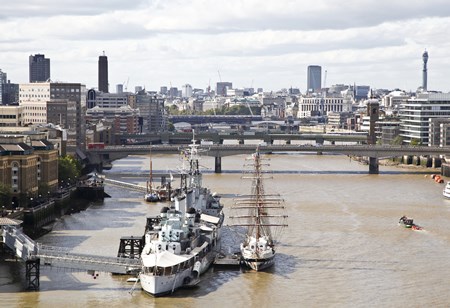
The British Navy has existed for hundreds of years, and in that time has been praised for its range and reach, the excellence of its manpower, the power of its weaponry, and the quality of the ships themselves.
From the early days of the service up until recent war efforts, the ships that have served as vessels under the monarchy have been the subjects of prose, song, poetry, art, and volumes of military history.
Today, many of these queens of the deep blue sea have been restored to their former glory and are public museums. These museum ships are funded and maintained by various organisations in addition to the British government, and draw tourists by the thousands from all over the world to the British isles to see them.
Here are our top ten historic ships, now open for your viewing pleasure.
1. HMS Warrior
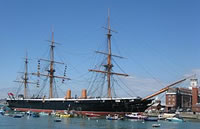 HMS Warrior, the first armour-plated and iron-hulled warship in the world, built in 1861, now a museum ship in Portsmouth, Hampshire.
HMS Warrior, the first armour-plated and iron-hulled warship in the world, built in 1861, now a museum ship in Portsmouth, Hampshire.This warship featured an armor-plated hull covered with iron, and was the first commissioned vessel of that type to enter the service of the Royal Navy, which it did in 1861.
The first warship to be clad in iron historically was the French ship Gloire, which was deemed seaworthy a year before the Warrior. As a rival to the French ship, the Warrior was superior in every way, being bigger, faster, possessed of more armament and armor than any other ship that had sailed before.
A ship the size of the Warrior had not been seen previously on the world stage, and the use of steam power and propeller, its construction of iron and armor-clad hull, and its huge guns, rifled and breech-loading, were all features that awed friend and foe alike.
The ship served the British Navy until 1883, and was restored and added to the National Historic Fleet in modern times. The Warrior is dry docked at Portsmouth in the UK.
For more information about this historic ship, opening times, location and ticket prices, see our page about Portsmouth Historic Dockyard.
2. HMS Victory
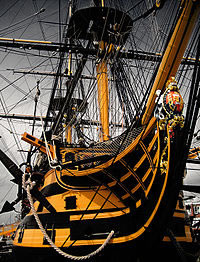 HMS Victory, a 104 gun Royal Navy ship, most famous as Lord Nelson's flagship at the Battle of Trafalgar in 1805, now docked at Portsmouth.
HMS Victory, a 104 gun Royal Navy ship, most famous as Lord Nelson's flagship at the Battle of Trafalgar in 1805, now docked at Portsmouth.As a warship with a long history of service in the Royal Navy, this former wanderer of the high seas has few peers. After her launching in 1765, she sailed the world under various sea captains.
In 1805 at the Battle of Trafalgar, she was commanded by Lord Nelson, and with the power of her 104 guns played an immensely important role in the historic conflict.
She was a flagship for Admirals Keppel, Howe, and Jervis in sea battles throughout the rest of the 1700s and into the next century, until she began serving as a harbour ship in 1824.
A dock at Portsmouth became her home in 1922, where she continues to be a commissioned flagship, the oldest one in the Navy, as well as a museum ship.
For more information about this historic ship, opening times, location and ticket prices, see our page about Portsmouth Historic Dockyard.
3. The Mary Rose
 The hull of the Mary Rose being sprayed at the facility in Portsmouth while a technician is servicing the system.
The hull of the Mary Rose being sprayed at the facility in Portsmouth while a technician is servicing the system.This antique vessel has a unique place among the museum ships of the Royal Navy. She first served as warship for King Henry the 8th in the Tudor Navy.
She fought in various battles with several countries for the next 33 years of her life, and as a result of her wartime injuries was essentially reconstructed in 1536. In 1545, the carrack-style ship was at the forefront of a sea-battle with the French, who were the invaders, when she was stricken and lost in the sea north of the Isle of Wight.
She lay in this watery resting place until 1971 when an intensive search uncovered her remains on the sea floor. After being salvaged in 1982, she was partially restored and put on display, along with priceless Tudor-period artifacts recovered with her, as a museum piece.
For more information about this historic ship, opening times, location and ticket prices, see our page about Portsmouth Historic Dockyard.
4. HMS Belfast
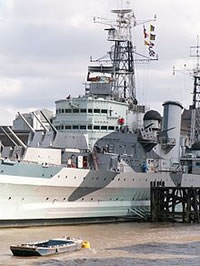 HMS Belfast, a Royal Navy light cruiser, now a museum ship moored next to Tower Bridge on the River Thames in London.
HMS Belfast, a Royal Navy light cruiser, now a museum ship moored next to Tower Bridge on the River Thames in London.A much more recent ship now on display as a museum is the HMS Belfast, which was commissioned as a light cruiser in the Royal Navy in 1939. As her first service she participated in the naval blockade of Germany, before colliding with a German mine and sustaining heavy damage.
After 2 years of reconstruction she became a paragon of the fleet in 1942, with upgraded weaponry, protective armor, and radar capabilities. During the war she was active in the Arctic, at the Battle of North Cape in 1943, and in the Normandy landings in 1944. After serving in the Pacific until the end of the war, she underwent modernisation in the 1950s and was active in the Korean conflict as well.
She was put on a reserve list in 1963, and is maintained by the Imperial War Museum on the Thames in London at her permanent home.
For more information about this historic ship, opening times, location and ticket prices, see our page about HMS Belfast.
5. SS Great Britain
 SS Great Britain, designed by Isambard Kingdom Brunel, the first iron steamer to cross the Atlantic in 1845. Now moored at Bristol dry dock and open to the public.
SS Great Britain, designed by Isambard Kingdom Brunel, the first iron steamer to cross the Atlantic in 1845. Now moored at Bristol dry dock and open to the public.This vessel was a passenger ship powered by steam, carrying people and cargo across the Atlantic from Bristol to New York and back. She was the first big ship to traverse the ocean that was constructed of iron and propeller-driven. She was also the record-holder for the fastest crossing of the Atlantic in 14 days in 1845.
The ship saw some hard times when her creator company went out of business and sold her for scrap. Fortunately, she was saved and repaired and brought back into service, traveling from England to Australia until 1881, when she underwent conversion to wind power. In the Falklands she was used in various capacities until retirement in 1937.
After being returned to the island of her birth in 1970, she became a museum ship and was moored permanently in Bristol Bay.
For more information about this historic ship, opening times, location and ticket prices, see our page about SS Great Britain.
6. The Cutty Sark
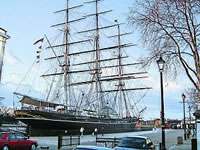 The Cutty Sark, a clipper ship built in 1869, preserved as a museum ship in dry dock in Greenwich, London.
The Cutty Sark, a clipper ship built in 1869, preserved as a museum ship in dry dock in Greenwich, London.A clipper ship constructed in 1869, this vessel was a merchant ship in her early years, then a training ship. Her design of a wooden hull over a frame made of iron, once common, makes her a rarity in the world.
She was being rebuilt and restored in 2007 when a fire did extensive damage. Plans are for her to be reopened to the public at her mooring in Greenwich, London, sometime in 2012.
For more information about this historic ship, opening times, location and ticket prices, see our page about The Cutty Sark.
7. HMY Britannia
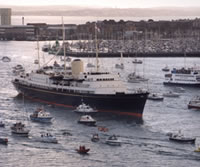 Her Majesty's Yacht Britannia is the former Royal Yacht of the British monarch, Queen Elizabeth II, now permanently moored as an exhibition ship at Ocean Terminal in Edinburgh, Scotland.
Her Majesty's Yacht Britannia is the former Royal Yacht of the British monarch, Queen Elizabeth II, now permanently moored as an exhibition ship at Ocean Terminal in Edinburgh, Scotland.This huge yacht is the former servant of Queen Elizabeth ii, and carries the official title of Royal Yacht. Commissioned in 1954, she hosted several US presidents and she was the honeymoon vessel for Charles and Diana in 1981.
Launched in Clydebank in 1953 at John Brown's shipyard, the Britannia has carried the Queen and the Royal family on no less than a whopping 968 offical trips around the world. Britannia is now a five-star historic visitor attraction as well as a prestigious hospitality venue available to hire.
As part of the National Historic Fleet, her permanent home is in the Port of Leith in Edinburgh, Scotland, where she attracts visitors from all over the world.
8. HMS Alliance
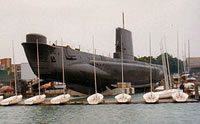 HMS Alliance (P417), a submarine launched in 1945 but not completed until 1947, and now a museum ship and the only surviving member of her class.
HMS Alliance (P417), a submarine launched in 1945 but not completed until 1947, and now a museum ship and the only surviving member of her class.This is the only submarine on the list, a Royal Navy A-class vessel. The ship served in the Far East and the Pacific by design, a location in which her ability to move at high speed on the surface, travel long distances under water, and keep her crew safe and comfortable were necessary improvements over previous ships that only had to travel relatively short distances.
The HMS Alliance has been a museum ship and a memorial since 1981. On display in Gosport, she is the target of a restoration and repair campaign after sustaining severe damage from pigeons and seawater over the last few years.
For more information about this historic ship, opening times, location and ticket prices, see our page about HMS Alliance.
9. HMS Cavalier
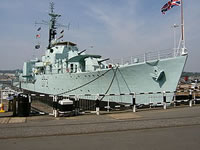 HMS Cavalier, a C-class destroyer launched in 1944, preserved as a museum ship and docked at Chatham Historic Dockyard.
HMS Cavalier, a C-class destroyer launched in 1944, preserved as a museum ship and docked at Chatham Historic Dockyard.A retired Royal Navy destroyer, this vessel received her commission in 1944. In World War II she saw action in the Pacific theatre. After the war she was put on reserve status until the 1950s when she was modernised and once again served in the Royal Navy.
After being decommissioned in 1972, she underwent restoration and is moored at the Chatham Historic Dockyard. In 2007 she was officially designated a memorial to destroyers of her class that were lost in the second World War, and to the 11,000 men who died while serving on them.
10. HMS Trincomalee
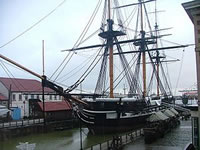 HMS Trincomalee, a Royal Navy Leda-class sailing frigate built shortly following the end of the Napoleonic Wars. She is now restored as a museum ship in Hartlepool, UK.
HMS Trincomalee, a Royal Navy Leda-class sailing frigate built shortly following the end of the Napoleonic Wars. She is now restored as a museum ship in Hartlepool, UK.This vessel is a frigate and one of only two still-existing ships of her type in the world. She started her life in 1817, was docked in Portsmouth in 1819, and converted to a different type of ship (a corvette) and relaunched in 1847.
She was a training ship, then passed into private ownership before being reclaimed and restored. She is now a museum ship and part of the National Historic Fleet, residing in Hartlepool, UK.
For more information about this historic ship, opening times, location and ticket prices, see our page about HMS Trincomalee.

 Popular
Popular Recent
Recent Comments
Comments

















